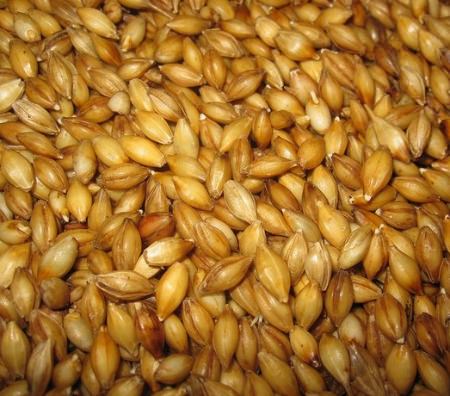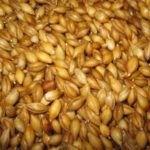 The video lesson plus written recipe features how to make sprouted grains at home and thus make your homemade sprouted flour for all your baking needs.
The video lesson plus written recipe features how to make sprouted grains at home and thus make your homemade sprouted flour for all your baking needs.
China is credited with developing the method for germinating seeds many centuries ago and on long ocean voyages, Chinese sailors used sprouted mung beans as a source of vitamin C for preventing scurvy.
Vitamin C is produced in significant quantities when you sprout seeds. It is absent from unsprouted seeds! Many other nutrients are increased substantially from sprouting grains, as I go over in the videos.
Sprouting Grain
Sprouted flour made from freshly ground sprouted grain is one of the 3 ways traditional societies used to prepare their grains before eating.
This careful preparation of wheat and other grains is necessary in order to break down the antinutrients, toxins, and difficult to digest proteins (i.e., gluten) so as to optimize digestibility and to allow maximum absorption of nutrients.
Unfortunately, this careful preparation method has been lost with our modern cooking methods which focus on speed and convenience rather than nutrient density and digestibility!
Equipment Needed to Sprout Grain
The first item you need to sprout is a half gallon size glass container with a screen lid (like this one). Many health food stores sell sprouting jars, but you can easily make one yourself at home using a glass jar and a clean pair of pantyhose cut to fit the lid of the jar and fastened with a rubber band.
Once you have your jar ready, fill it no more than halfway with the grain you wish to sprout. I use organic spelt or organic soft white wheat that I obtain from my local grain co-op. For other ideas, visit my Resources page.

Sprouting Grains Recipe
How to sprout grains at home easily and cost effectively that will improve the nutrient value of your baked goods. Recipe can be used to sprout any types of grain.
Instructions
-
Place the wheat berries in the sprouting jar and affix the screen lid.
-
Rinse and drain the wheat grains several times with filtered water until the berries are completely wet.
-
Fill the jar until almost full with water and let the berries soak overnight on the kitchen counter.
-
The next morning, tip the jar and drain out the water using the screen lid to prevent the berries from spilling out. Rinse the wheat one more time and then invert the jar and let it sit at an angle to facilitate draining and allowing the circulation of air.
-
Rinse the wheat one more time and then invert the jar and let it sit at an angle to facilitate draining and allowing the circulation of air. I use my grain grinder as a support for the jar so that the draining occurs right over the kitchen sink.
-
Every few hours, rinse the wheat again and reset the jar in the draining position.
-
In anywhere from a few hours to a few days (depending on the time of year and warmth/humidity in your home), small white buds will appear on the ends of the wheat kernels. See the picture for what it should look like.
-
When this occurs, pour the sprouted wheat kernels into baking pans and place in a dehydrator or a warm oven (150 F/ 66 C) for about 24 hours until fully dried.
-
Store the sprouted grains in an airtight container in the refrigerator, or grind immediately and then freeze the sprouted flour. Use sprouted flour just like you would use regular flour in your favorite baking recipes.
Sprouted Grain Recipes to Try
Baked goods made with sprouted flour are much more digestible/filling. As a result, you will find that you eat much less of the same item when you use sprouted flour!
Try making this sprouted flour pizza crust or these sprouted flour brownies with your sprouted flour!
Where to Find Organic or Already Sprouted Grain
If after watching these two short videos on sprouted grains below you have interest in trying your hand at making your own sprouted flour for baking, please visit my Resources page for where to buy quality sprouted grains for grinding into fresh sprouted flour (my favorite is einkorn … completely unhybridized wheat) or to locate suppliers of organic grain for making sprouted grains at home yourself.
How to Make Sprouted Grains (Videos)
The two videos below demonstrate how to sprout grains. The first video shows the soaking process and the second the sprouting process.
Sarah, The Healthy Home Economist
More Information
Teff Grains (sprouted or not) Deliver Big on Nutrition
Amaranth: Superfood of the Aztecs








I dehydrated the grains in my oven (which has the lowest temperature of 170 degrees) and they came out very hard. Is that what they’re supposed to be like?
Hi Sarah,
So am I understanding you correctly that the process is to sprout the wheat, grind it and then resoak the flour before making baked goods?
Hello :0)
Will my vitamix work to grind the dried sprouts? Or do I have to use a wheat grinder?
Thank you for this video. It was very helpful.
Hi Sarah,
Can you use sprouted grain flour to make sourdough starter? I have lots of organic rye berries and my old starter played out because I was unable to refresh it for a while. I need to make a new starter and if you think it’s possible with sprouted flour I’d like to try. Thanks.
I know this question has been asked before, but are there specific recipes for using sprouted flour? I have been sprouting, drying and grinding flour for about 6 months now and am finding the bread I make with recipes I’ve used in the past (with reg wheat flour) to be heavier and denser than normal (even after adding white flour to lighten them up). Do you have any secrets or recipes you can share to help us here?
thanks Sarah!
I am currently grinding grain in a Vitamix. Can I use it to grind the sprouted wheat berries as well?
Do you recommend a certain type of wheat berries (ie. hard red winter, soft white, etc.)?
Thanks!
Hi Sarah,
I just want to thank you for your video tutorials. I have been cooking for my family using some traditional methods for about a year. After watching your tutorials I have more confidence to try more and more traditional methods. Thank you for your time and dedication to providing healthy alternatives for me and my family 🙂
I kept watching the video hoping to actually see the sprouted grain being ground. I have a Nutrimill and when I try to grind the dried sprouted flour, it just gums up the works.
Hi Teriz – There is a chance that your grain is not sufficiently dried. Maybe the climate where you live requires a bit more drying time. Over-drying is ok, but under-drying is what will gum up your machine.
Do you use sprouted flour or just regular ground flour to make biscuits and pancakes. I want to get some wheat and grind it for biscuits. My elderly mother has wanted me to buy some self-rising flour and crisco so she can make some biscuits and I’m trying to get her to wait until I get some leaf fat and make some lard and get some wheat berries and grind my on flour. If flour loses it’s nutrition after 3 days, the stuff at the store is useless. The flour at the store also has aluminum based baking powder in it and I don’t like that. Crisco is just like eating poison, in my opinion.